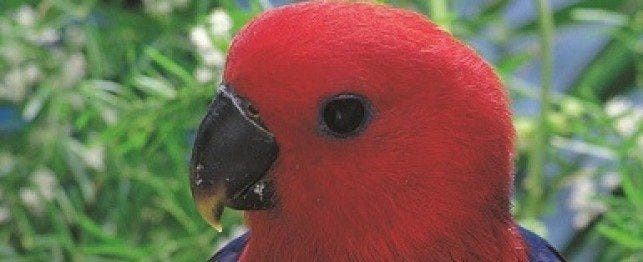
Choosing a Grand Eclectus
Eclectus are short, stocky birds with square tails, and are unique among parrots in that their striking plumage color immediately sets one sex apart from another. The females of the species are deep scarlet to bright red with black beaks and blue patches; males are brilliant green with yellow-orange beaks. The differences in their looks are so stunning, in fact, that early ornithologists considered them different species.
This was wrong, of course: All eclectus parrots are part of the species Eclectus roratus, although there are up to nine recognized subspecies, which are found in Australia, New Guinea and the South Pacific Islands. Among the subspecies, females have distinctive differences in plumage; males of the various subspecies, however, are difficult to tell apart, which often leads to inadvertent hybridization.
The grand eclectus – sometimes called the king parrot, Ceram eclectus or the kalanga – is found on several Indonesian islands and was imported into the United States many years ago. Here, they were often bred simply as eclectus, so many “grand eclectus” that turn up in the United States may actually be hybrids. As parrots go, the birds are relatively affordable, ranging in price between $1,200 and $2,000.
In general, these birds are independent and don’t form as strong of bonds as with other parrots. However, they are interested in activities around them and want to be part of the family. They should always be provided with toys, especially wooden blocks, and branches from non-toxic trees. Males tend to be the gentler sex, but this is controversial. For this reason, many people feel that males are more appropriate for families with smaller children.
Although eclectus have previously been considered better aviary birds than pets, this opinion is rapidly changing. Many people have enjoyed these beautiful birds as wonderful and enchanting pets. They don’t talk as well as other parrots but are very clean and relatively odorless. Their life span can exceed 40 years.
Feeding
Eclectus do well when provided with plenty of fruits and vegetables. Their diet should be comprised of 75 to 80 percent fruits and vegetables and 20 to 25 percent pellets. Treats may be given in small amounts especially as rewards for good behavior. Fresh clean water must be provided every day. Vitamin supplements are not needed for birds that are eating a formulated and nutritionally rich diet.
Grooming
Routine bathing or showering is vital to maintaining good plumage and skin condition. The fine feathering of the eclectus is especially beautiful when they receive routine baths. Ideally birds should be taken outdoors on a warm day and lightly sprinkled and allowed to dry in the sun. Indoor birds can be misted or bathed in the shower and allowed to dry in a warm room or dried with a blow drier.
Care should be taken not to clip the wing feathers excessively. Clip only enough so the bird will glide to the floor.
Housing
Eclectus should be provided with as large a cage as possible. At the very least, the cage needs to be large enough to allow the birds to fully extend their wings. Ideally, the birds will also be provided an outdoor cage. Appropriate toys should be provided.
Breeding
Breeding season and clutch size – Eclectus parrots are prolific breeders and many pairs will breed year round. The prominent breeding season is the spring. Females may be aggressive toward males. There are reports of eclectus breeding successfully over age 28.
Some eclectus breed in nest boxes and some breed on perches. Provide a Z-box, rectangular or vertical nest box approximately 18 inches by 18 inches by 24 inches. Females may stay in the box most of the time. Pine shavings make excellent nest material. Breeding cage should be as large as practical but at least 3 feet by 3 feet by 6 feet.
Eclectus are easy to hand rear and will do well on hand rearing formulas. The sexes can be distinguished at a very early age and the down tends to be black in female chicks and grey in males. At about 4 to 5 weeks, the head will take on a green or red cast as feathers emerge and tails feathers will begin to emerge verifying sex. Eclectus chicks must be handled very gently to avoid fearful or aggressive behavior.
Common Diseases and Disorders
The grand eclectus is a relatively healthy bird. The following diseases have been reported in this bird.
- Feather picking
- Psittacine beak and feather disease
- Polyoma virus infection
- Psittacosis
- Vitamin A deficiency
- Bacterial infections
- Candida (yeast) infections
- Ingestion of toxins such as heavy metals
- Infertility and female aggression